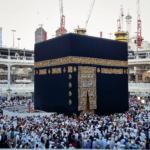Hajj and Umrah
Hajj:
Hajj is one of the five pillars of Islam and is considered the ultimate act of worship for Muslims. It takes place annually in the Islamic month of Dhu al-Hijjah, specifically during the days from the 8th to the 12th. Millions of Muslims from all corners of the globe converge upon the holy city of Mecca in Saudi Arabia to perform the rites of Hajj.
The rituals of Hajj trace back to the time of the Prophet Muhammad (peace be upon him) and commemorate the actions of the Prophet Ibrahim (Abraham) and his family. These rituals include:
Ihram
Pilgrims enter a state of consecration, wearing simple white garments, symbolizing equality and unity among all Muslims, irrespective of their social status or nationality.
Tawaf
Circumambulating the Kaaba, the sacred cubic structure at the center of the Masjid al-Haram in Mecca, seven times, while reciting prayers and supplications.
Sa'i
Walking between the hills of Safa and Marwa seven times, reenacting Hagar's search for water for her son Isma'il, according to Islamic tradition.
Mount Arafat
Pilgrims gather on the plains of Arafat, where they stand in prayer and contemplation, seeking forgiveness and mercy from Allah.
Stoning of the Devil (Rami al-Jamarat)
Symbolically casting stones at three pillars representing Satan's temptation of Prophet Ibrahim, signifying the rejection of evil.
Eid al-Adha
The climax of Hajj is marked by the celebration of Eid al-Adha, commemorating Ibrahim's willingness to sacrifice his son Isma'il as an act of obedience to God.
Tawaf al-Ifadah
A final circumambulation of the Kaaba upon returning from Arafat.
Farewell Tawaf
Before leaving Mecca, pilgrims perform a final circumambulation of the Kaaba as a farewell to the holy city.
Umrah:
Umrah, often referred to as the lesser pilgrimage, is a voluntary act of worship that can be performed at any time of the year, unlike Hajj, which has specific dates. While not obligatory, it holds great spiritual significance for Muslims and is an opportunity for them to seek blessings and forgiveness from Allah.
The rituals of Umrah are similar to certain aspects of Hajj but are generally shorter and less extensive. They include:
Ihram
Just like in Hajj, pilgrims enter a state of consecration by wearing the prescribed attire and observing specific restrictions.
Tawaf
Circumambulating the Kaaba seven times, expressing devotion and reverence to Allah.
Sa'i
Walking between Safa and Marwa seven times, emulating Hagar's actions in search of water.
Shaving or trimming of hair
Upon completing the Sa'i, pilgrims, particularly men, shave their heads or trim their hair as a symbol of purification and humility.
Umrah can be performed independently or in conjunction with Hajj, and it holds immense spiritual rewards for those who undertake it sincerely. It provides Muslims with an opportunity to strengthen their faith, seek forgiveness for their sins, and draw closer to Allah.
In essence, both Hajj and Umrah represent acts of devotion, submission, and spiritual renewal, serving as profound reminders of the core principles of Islam and the unity of the Muslim Ummah.





